Introduction
There are approximately four million street-legal motorcycles registered in the United States. Each year one out of every 35 of those motorcycles is involved in a crash and one out of ever 1,200 or so is involved in a fatal crash.
When fatalities per miles traveled are considered, motorcyclists are killed at about 19 times the rate of drivers and passengers of other motor vehicles. The National Highway Traffic Safety Administration (NHTSA) estimates that alcohol is a contributing factor in nearly half of all motorcycle fatalities.
Clearly, enforcement of DWI laws is a key to reducing the number of alcohol-related motorcyclist fatalities. But what are the clues that we should use to detect impaired motorcyclists?
NHTSA sponsored the research necessary to develop a set of behavioral cues that can be used by law enforcement personnel to accurately detect motorcyclists who are operating their vehicles while intoxicated. The researchers began by interviewing expert patrol officers from across the country to determine what behavioral cues have been used to detect impaired motorcyclists. Most officers recalled at least a few cues that they use to discriminate between DWI and normal riding. A few, primarily motorcycle officers, suggested cues that reflected considerable understanding of the mental and physical requirements of riding a motorcycle. Others believed the cues to be identical to those used to detect impaired drivers. But some officers, even those with many years experience, reported that they believe there to be no cues that can be used to distinguish DWI for unimpaired motorcycle operation.
In addition to interviewing law enforcement personnel, the research team developed the data base of 1,000 motorcycle DWI arrest reports. They focused on the officer's narratives and the behaviors that motivated the stops, and correlated those behaviors with blood alcohol concentrations, or BACs. Analysis of the interviews and arrest report data resulted in an inventory of about 100 cues that have been observed by officer in association with impaired motorcycle operation.
The researchers, working closely with the law enforcement personnel, conducted two major field studies involving more than 50 sites throughout the United States. Officers recorded information about every enforcement stop they made of a motorcyclist. Those field studies permitted the researchers to identify the most effective cues and to calculate the probabilities that those cues are predictive of DWI. This training document presents the results of the research.
Fourteen cues were identified that best discriminate between DWI and unimpaired operation of a motorcycle. The cues have been labeled as "Excellent Predictors" and "Good Predictors," based on study results. The excellent cues predicted impaired motorcycle operation 50 percent or more of the time. The good cues predicted impaired motorcycle operation 30 to 49 percent of the time. The special coordination and balance requirements of riding a two-wheeled vehicle provided most of the behaviors in the excellent category of cues.
Important Information
The cues described in the following (pages) have been used by law enforcement officers from across the United States to help detect impaired motorcycle operators. The cues can be used at all hours of the day and night, and they apply to all two-wheeled motor vehicles.
The cues described and illustrated in this document (and the accompanying detection guide and training video) are the behaviors that are most likely to discriminate between impaired and normal operation of a motorcycle. However, the special case of "speeding" requires elaboration. Motorcyclists stopped for excessive speed are likely to be DWI only about 10 percent of the time (i.e., ten times out of a 100 stops for speeding). But because motorcyclists tend to travel in excess of speed limits, speeding is associated with a large portion of all motorcycle DWI arrests. In other words, while only a small proportion of speeding motorcyclists are likely to be DWI, the large number of speeding motorcyclists results in a large number of DWIs, despite the relatively small probability.
The research suggests that these training materials, and the Motorcycle DWI Detection Guide, will be helpful to officers in:
- Detecting impaired motorcyclists,
- Articulating observed behaviors on arrest reports, and
- Supporting officer's expert testimony.
Drifting During Turn or Curve
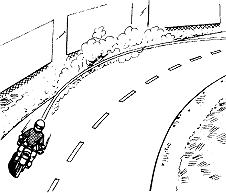 Earlier studies have shown that the most common cause of single-vehicle, fatal motorcycle crashes is for the road to curve and the motorcycle and rider to continue in a straight line until they strike a stationary object; this type of crash is usually caused by alcohol impaired balance and coordination abilities. In less extreme cases, the motorcycle's turn radius expands during the maneuver. The motorcycle appears to drift to the outside of the lane, or into another lane, though the curve or while turning a corner. If you see a motorcycle drifting during a turn or curve, do the rider a favor and pull him over -- our study showed there is an excellent chance that he is DWI.
Earlier studies have shown that the most common cause of single-vehicle, fatal motorcycle crashes is for the road to curve and the motorcycle and rider to continue in a straight line until they strike a stationary object; this type of crash is usually caused by alcohol impaired balance and coordination abilities. In less extreme cases, the motorcycle's turn radius expands during the maneuver. The motorcycle appears to drift to the outside of the lane, or into another lane, though the curve or while turning a corner. If you see a motorcycle drifting during a turn or curve, do the rider a favor and pull him over -- our study showed there is an excellent chance that he is DWI.
Trouble with Dismount
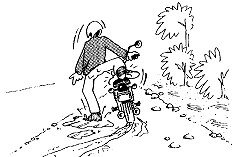 Parking and dismounting a motorcycle can be a helpful field sobriety test. The motorcyclist must turn off the engine, and locate and deploy the kickstand. He must then balance his weight on one foot while swinging the other foot over the seat to dismount. But first, the operator must decide upon a safe place to stop his bike. Problems with any step in this sequence can be evidence of alcohol impairment.
Parking and dismounting a motorcycle can be a helpful field sobriety test. The motorcyclist must turn off the engine, and locate and deploy the kickstand. He must then balance his weight on one foot while swinging the other foot over the seat to dismount. But first, the operator must decide upon a safe place to stop his bike. Problems with any step in this sequence can be evidence of alcohol impairment.
Not every motorcyclist that you see having some form of trouble with a dismount is under the influence, but study results indicated that more than 50 percent of them are. In other words, trouble with dismount is an excellent clue.
Trouble with Balancing at Stop
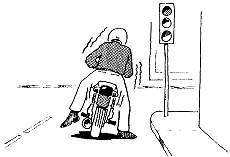 The typical practice at a stop is for the motorcyclist to place one foot on the ground to keep the bike upright, while leaving the other foot on the peg nearest the gear shift lever. Some riders favor placing both feet on the ground for stability. Riders whose balance has been impaired by alcohol often have difficulty with this task. They might be observed to shift their weight from side-to-side, that is from one foot to another to maintain balance at a stop. From a block away, an officer might notice a single tail light moving from side to side in a gentle rocking motion. If you observe a motorcyclist to be having trouble with balance at a stop, there is an excellent chance that he or she is DWI.
The typical practice at a stop is for the motorcyclist to place one foot on the ground to keep the bike upright, while leaving the other foot on the peg nearest the gear shift lever. Some riders favor placing both feet on the ground for stability. Riders whose balance has been impaired by alcohol often have difficulty with this task. They might be observed to shift their weight from side-to-side, that is from one foot to another to maintain balance at a stop. From a block away, an officer might notice a single tail light moving from side to side in a gentle rocking motion. If you observe a motorcyclist to be having trouble with balance at a stop, there is an excellent chance that he or she is DWI.
|
Turning Problems
The research identified four turning problems that are indicative of rider impairment. Each of the problems is described separately in the following paragraphs.
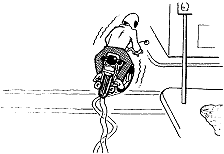 Unsteady During Turn or Curve. Unsteady During Turn or Curve. The gyroscopic effects of a motorcycle's wheels tend to keep a motorcycle "on track" as long as speed is maintained. As a motorcycle's speed decreases, the demands place on the operator's balance capabilities increase. As a result, an officer might observe a motorcycle's front wheels or handlebars to wobble as an impaired operator attempts to maintain balance at slow speeds or during a turn.
|
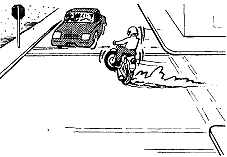 Late Braking During turn. Late Braking During turn. The next turning problem is "late braking during a turn or on a curve." A motorcyclist normally brakes prior to entering a turn or curve, so the motorcycle can accelerate through the maneuver for maximum control. An impaired motorcyclist might misjudge his speed or distance to the corner or curve, requiring him to apply the brakes during the maneuver. |
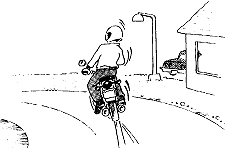 Improper Lean Angle During Turn. Improper Lean Angle During Turn. Third, a motorcyclist normally negotiates a turn or curve by leaning into the turn. However, when balance or speed judgment are impaired, the operator frequently attempts to sit upright through the maneuver. An "improper lean angle" can be detected by the trained observer. |
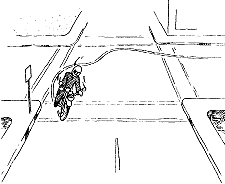 Erratic Movements During Turn. Erratic Movements During Turn.The fourth turning problem is "erratic movements." An erratic movement or sudden correction of a motorcycle during a turn or curve can also indicate impaired operator ability. |
If you observe a motorcyclist to be unsteady during a turn or curve, brake late, assume an improper lean angle, or make erratic movements during a turn or curve, there is an excellent chance that the motorcyclist is DWI.
Inattentive to Surroundings
Vigilance concerns a person's ability to pay attention to a task or notice changes in surroundings. A motorcyclist whose vigilance has been impaired by alcohol might fail to notice that the light that he has been waiting for has changed to green.
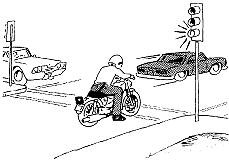 A vigilance problem is also evident when a motorcyclist is inattentive to his surroundings or seemingly unconcerned with detection. For example, there is cause for suspicion of DWI when a motorcyclist fails to periodically scan the area around his bike when in traffic, as wise defensive riding procedure to guard against potential encroachment by other vehicles. There is further evidence of impairment if a motorcyclist fails to respond to an officer's emergency lights or hand signals.
A vigilance problem is also evident when a motorcyclist is inattentive to his surroundings or seemingly unconcerned with detection. For example, there is cause for suspicion of DWI when a motorcyclist fails to periodically scan the area around his bike when in traffic, as wise defensive riding procedure to guard against potential encroachment by other vehicles. There is further evidence of impairment if a motorcyclist fails to respond to an officer's emergency lights or hand signals.
If you observe a motorcyclist to be inattentive to his or her surroundings, there is an excellent chance that the motorcyclist is DWI.
Inappropriate or Unusual Behavior
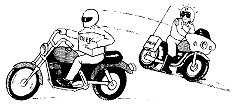 There is a category of clues that we call "inappropriate or unusual behavior." This category of cues includes behavior such as operating a motorcycle while holding an object in one hand or under an arm, carrying an open container of alcohol, dropping an item from a motorcycle, urinating at the roadside, arguing with another motorist or otherwise being disorderly. If you observe inappropriate or unusual behavior by a motorcyclist, there is an excellent probability that the motorcyclist is DWI.
There is a category of clues that we call "inappropriate or unusual behavior." This category of cues includes behavior such as operating a motorcycle while holding an object in one hand or under an arm, carrying an open container of alcohol, dropping an item from a motorcycle, urinating at the roadside, arguing with another motorist or otherwise being disorderly. If you observe inappropriate or unusual behavior by a motorcyclist, there is an excellent probability that the motorcyclist is DWI.
Weaving
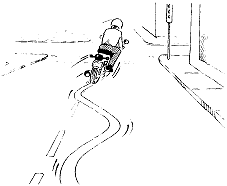 You are probably familiar with weaving as a predictor of DWI. If you see an automobile weaving there is a good chance that the driver has exceeded the legal limits on alcohol, but if you observe a motorcycle to be weaving, the probability of DWI is even greater -- weaving is an excellent cue. Weaving includes weaving within a lane and weaving across land lines, but does not include the movements necessary to avoid road hazards.
You are probably familiar with weaving as a predictor of DWI. If you see an automobile weaving there is a good chance that the driver has exceeded the legal limits on alcohol, but if you observe a motorcycle to be weaving, the probability of DWI is even greater -- weaving is an excellent cue. Weaving includes weaving within a lane and weaving across land lines, but does not include the movements necessary to avoid road hazards.
Erratic Movements While Going Straight
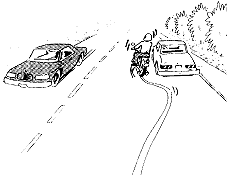 If you observe a motorcyclist making erratic movements or sudden corrections while attempting to ride in a straight line, study results indicated there is a good probability that the rider is DWI. In other words, during the study between 30 and 49 percent of the time erratic movements while going straight were observed in association with impaired operation.
If you observe a motorcyclist making erratic movements or sudden corrections while attempting to ride in a straight line, study results indicated there is a good probability that the rider is DWI. In other words, during the study between 30 and 49 percent of the time erratic movements while going straight were observed in association with impaired operation.
Operating without Lights at Night
 Operating a motorcycle without lights at night is very dangerous and can indicate operator-impairment. Study results showed that if you detect a motorcyclist riding at night without lights, there is a good chance that the operator is DWI.
Operating a motorcycle without lights at night is very dangerous and can indicate operator-impairment. Study results showed that if you detect a motorcyclist riding at night without lights, there is a good chance that the operator is DWI.
Recklessness
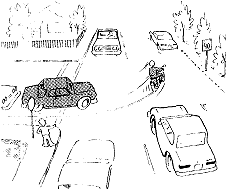 Motorcyclists tend to ride faster than autos, so speeding is not necessarily a good predictor of DWI for motorcyclists. However, recklessness, or riding too fast for the condition, was found to be a good indicator of operator impairment.
Motorcyclists tend to ride faster than autos, so speeding is not necessarily a good predictor of DWI for motorcyclists. However, recklessness, or riding too fast for the condition, was found to be a good indicator of operator impairment.
Following Too Closely
 Following too closely, an unsafe following distance, is an indication of impaired operator judgement. This cue was found during the study to be a good predictor of motorcycle DWI.
Following too closely, an unsafe following distance, is an indication of impaired operator judgement. This cue was found during the study to be a good predictor of motorcycle DWI.
Running Stop Light or Sign
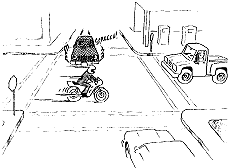 Failure to stop at a red light or stop sign can indicate either impaired vigilance capabilities (i.e., did not see the stop light or sign -- or officer), or impaired judgement (i.e., decided not to stop). What ever the form of impairment, if you observe a motorcyclist to run a stop light or sign, there is a good chance that he or she is DWI.
Failure to stop at a red light or stop sign can indicate either impaired vigilance capabilities (i.e., did not see the stop light or sign -- or officer), or impaired judgement (i.e., decided not to stop). What ever the form of impairment, if you observe a motorcyclist to run a stop light or sign, there is a good chance that he or she is DWI.
Evasion
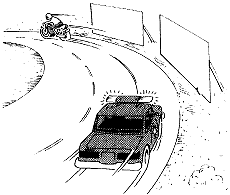 Evasion, or fleeing an officer, is a relatively frequent occurrence. If a motorcyclist attempts to evade an officer's enforcement stop, study results indicate that there's a good chance he's DWI.
Evasion, or fleeing an officer, is a relatively frequent occurrence. If a motorcyclist attempts to evade an officer's enforcement stop, study results indicate that there's a good chance he's DWI.
Wrong Way
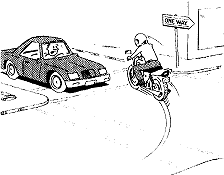 Obviously, riding into opposing traffic is extremely dangerous. Study results showed that when you find a motorcycle going the wrong way in traffic there is a good chance that the operator is under the influence. This includes going the wrong way on a one way street, and crossing a center divider line to ride into opposing traffic.
Obviously, riding into opposing traffic is extremely dangerous. Study results showed that when you find a motorcycle going the wrong way in traffic there is a good chance that the operator is under the influence. This includes going the wrong way on a one way street, and crossing a center divider line to ride into opposing traffic.
THE CAPPER
Pocket-sized Flash Card
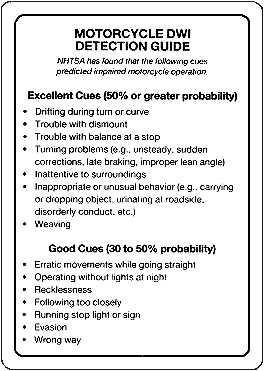
I guess it follows that when NHTSA spreads this type of information on a subject, they like to make sure to get the maximum impact. So, it makes sense then that a 3X4 laminated card would be included with the brochure -- in a special pocket fitted into the front cover -- to serve as a reminder of the wisdom of the great and insightful NHTSA.
Maybe we should see if we can get some of these to be handed out to bikers who have from time to time, without a trace of alcohol in their system, committed every one of the foregoing cues.
I wonder what this piece would have read like if they it had not been put together by bigots. We'll all have to wonder, because we'll never know.
quig
General comments by: Don Blanscet
Roger Bacon | Peter Danes
Kevin Dimmick |Kelly Prince
YOU?
 Earlier studies have shown that the most common cause of single-vehicle, fatal motorcycle crashes is for the road to curve and the motorcycle and rider to continue in a straight line until they strike a stationary object; this type of crash is usually caused by alcohol impaired balance and coordination abilities. In less extreme cases, the motorcycle's turn radius expands during the maneuver. The motorcycle appears to drift to the outside of the lane, or into another lane, though the curve or while turning a corner. If you see a motorcycle drifting during a turn or curve, do the rider a favor and pull him over -- our study showed there is an excellent chance that he is DWI.
Earlier studies have shown that the most common cause of single-vehicle, fatal motorcycle crashes is for the road to curve and the motorcycle and rider to continue in a straight line until they strike a stationary object; this type of crash is usually caused by alcohol impaired balance and coordination abilities. In less extreme cases, the motorcycle's turn radius expands during the maneuver. The motorcycle appears to drift to the outside of the lane, or into another lane, though the curve or while turning a corner. If you see a motorcycle drifting during a turn or curve, do the rider a favor and pull him over -- our study showed there is an excellent chance that he is DWI.
 Parking and dismounting a motorcycle can be a helpful field sobriety test. The motorcyclist must turn off the engine, and locate and deploy the kickstand. He must then balance his weight on one foot while swinging the other foot over the seat to dismount. But first, the operator must decide upon a safe place to stop his bike. Problems with any step in this sequence can be evidence of alcohol impairment.
Parking and dismounting a motorcycle can be a helpful field sobriety test. The motorcyclist must turn off the engine, and locate and deploy the kickstand. He must then balance his weight on one foot while swinging the other foot over the seat to dismount. But first, the operator must decide upon a safe place to stop his bike. Problems with any step in this sequence can be evidence of alcohol impairment.
 The typical practice at a stop is for the motorcyclist to place one foot on the ground to keep the bike upright, while leaving the other foot on the peg nearest the gear shift lever. Some riders favor placing both feet on the ground for stability. Riders whose balance has been impaired by alcohol often have difficulty with this task. They might be observed to shift their weight from side-to-side, that is from one foot to another to maintain balance at a stop. From a block away, an officer might notice a single tail light moving from side to side in a gentle rocking motion. If you observe a motorcyclist to be having trouble with balance at a stop, there is an excellent chance that he or she is DWI.
The typical practice at a stop is for the motorcyclist to place one foot on the ground to keep the bike upright, while leaving the other foot on the peg nearest the gear shift lever. Some riders favor placing both feet on the ground for stability. Riders whose balance has been impaired by alcohol often have difficulty with this task. They might be observed to shift their weight from side-to-side, that is from one foot to another to maintain balance at a stop. From a block away, an officer might notice a single tail light moving from side to side in a gentle rocking motion. If you observe a motorcyclist to be having trouble with balance at a stop, there is an excellent chance that he or she is DWI.
 Unsteady During Turn or Curve.
Unsteady During Turn or Curve.  Late Braking During turn.
Late Braking During turn.  Improper Lean Angle During Turn.
Improper Lean Angle During Turn.  Erratic Movements During Turn.
Erratic Movements During Turn. A vigilance problem is also evident when a motorcyclist is inattentive to his surroundings or seemingly unconcerned with detection. For example, there is cause for suspicion of DWI when a motorcyclist fails to periodically scan the area around his bike when in traffic, as wise defensive riding procedure to guard against potential encroachment by other vehicles. There is further evidence of impairment if a motorcyclist fails to respond to an officer's emergency lights or hand signals.
A vigilance problem is also evident when a motorcyclist is inattentive to his surroundings or seemingly unconcerned with detection. For example, there is cause for suspicion of DWI when a motorcyclist fails to periodically scan the area around his bike when in traffic, as wise defensive riding procedure to guard against potential encroachment by other vehicles. There is further evidence of impairment if a motorcyclist fails to respond to an officer's emergency lights or hand signals.
 There is a category of clues that we call "inappropriate or unusual behavior." This category of cues includes behavior such as operating a motorcycle while holding an object in one hand or under an arm, carrying an open container of alcohol, dropping an item from a motorcycle, urinating at the roadside, arguing with another motorist or otherwise being disorderly. If you observe inappropriate or unusual behavior by a motorcyclist, there is an excellent probability that the motorcyclist is DWI.
There is a category of clues that we call "inappropriate or unusual behavior." This category of cues includes behavior such as operating a motorcycle while holding an object in one hand or under an arm, carrying an open container of alcohol, dropping an item from a motorcycle, urinating at the roadside, arguing with another motorist or otherwise being disorderly. If you observe inappropriate or unusual behavior by a motorcyclist, there is an excellent probability that the motorcyclist is DWI.
 You are probably familiar with weaving as a predictor of DWI. If you see an automobile weaving there is a good chance that the driver has exceeded the legal limits on alcohol, but if you observe a motorcycle to be weaving, the probability of DWI is even greater -- weaving is an excellent cue. Weaving includes weaving within a lane and weaving across land lines, but does not include the movements necessary to avoid road hazards.
You are probably familiar with weaving as a predictor of DWI. If you see an automobile weaving there is a good chance that the driver has exceeded the legal limits on alcohol, but if you observe a motorcycle to be weaving, the probability of DWI is even greater -- weaving is an excellent cue. Weaving includes weaving within a lane and weaving across land lines, but does not include the movements necessary to avoid road hazards. If you observe a motorcyclist making erratic movements or sudden corrections while attempting to ride in a straight line, study results indicated there is a good probability that the rider is DWI. In other words, during the study between 30 and 49 percent of the time erratic movements while going straight were observed in association with impaired operation.
If you observe a motorcyclist making erratic movements or sudden corrections while attempting to ride in a straight line, study results indicated there is a good probability that the rider is DWI. In other words, during the study between 30 and 49 percent of the time erratic movements while going straight were observed in association with impaired operation. Operating a motorcycle without lights at night is very dangerous and can indicate operator-impairment. Study results showed that if you detect a motorcyclist riding at night without lights, there is a good chance that the operator is DWI.
Operating a motorcycle without lights at night is very dangerous and can indicate operator-impairment. Study results showed that if you detect a motorcyclist riding at night without lights, there is a good chance that the operator is DWI. Motorcyclists tend to ride faster than autos, so speeding is not necessarily a good predictor of DWI for motorcyclists. However, recklessness, or riding too fast for the condition, was found to be a good indicator of operator impairment.
Motorcyclists tend to ride faster than autos, so speeding is not necessarily a good predictor of DWI for motorcyclists. However, recklessness, or riding too fast for the condition, was found to be a good indicator of operator impairment. Following too closely, an unsafe following distance, is an indication of impaired operator judgement. This cue was found during the study to be a good predictor of motorcycle DWI.
Following too closely, an unsafe following distance, is an indication of impaired operator judgement. This cue was found during the study to be a good predictor of motorcycle DWI. Failure to stop at a red light or stop sign can indicate either impaired vigilance capabilities (i.e., did not see the stop light or sign -- or officer), or impaired judgement (i.e., decided not to stop). What ever the form of impairment, if you observe a motorcyclist to run a stop light or sign, there is a good chance that he or she is DWI.
Failure to stop at a red light or stop sign can indicate either impaired vigilance capabilities (i.e., did not see the stop light or sign -- or officer), or impaired judgement (i.e., decided not to stop). What ever the form of impairment, if you observe a motorcyclist to run a stop light or sign, there is a good chance that he or she is DWI. Evasion, or fleeing an officer, is a relatively frequent occurrence. If a motorcyclist attempts to evade an officer's enforcement stop, study results indicate that there's a good chance he's DWI.
Evasion, or fleeing an officer, is a relatively frequent occurrence. If a motorcyclist attempts to evade an officer's enforcement stop, study results indicate that there's a good chance he's DWI. Obviously, riding into opposing traffic is extremely dangerous. Study results showed that when you find a motorcycle going the wrong way in traffic there is a good chance that the operator is under the influence. This includes going the wrong way on a one way street, and crossing a center divider line to ride into opposing traffic.
Obviously, riding into opposing traffic is extremely dangerous. Study results showed that when you find a motorcycle going the wrong way in traffic there is a good chance that the operator is under the influence. This includes going the wrong way on a one way street, and crossing a center divider line to ride into opposing traffic.